Disclosure: This post may contain affiliate links. I earn from any qualifying purchases, at no additional cost to you.
This post is a Hampi Travel Guide that contains a detailed Hampi 2-day Itinerary.
Hampi, a temple town in Karnataka is a UNESCO world heritage site situated on the banks of the Tungabhadra river. Once the capital of the Vijayanagara Empire in the 14th century, Hampi was known to be a wealthy, prosperous and monumental city. Not only was Hampi the world's second-largest medieval-era city after Beijing, it was also India's richest city at the time. The grandeur of the ancient city is still prevalent in the majestic temples and the striking ruins, perched across a craggy landscape surrounded by lush banana plantations. I had read about and seen countless pictures of Hampi. I kept planning a trip and it kept getting delayed due to some reason or another. My family has a tradition of taking a road trip every January. Guess which place I suggested for our trip!
As the ruins of the Vijayanagara Empire are spread over an area of 26 sq. km in and around Hampi, there are 2 options to explore them. If you have limited time then you can cover the more popular/ mainstream sites in 1 day. Whereas, if you wish to soak in the royalty and enjoy the architecture, then a 2 day trip to Hampi is the better option. Keeping both scenarios in mind, I have written about a 2-day itinerary for Hampi. Furthermore, I will be mentioning the sites which can be skipped so that you can squeeze in the important sites in one day. In case you want to see more pictures of Hampi and other destinations, then visit my Instagram profile (@thespicyjourney).
Table of Contents
How to Reach Hampi
Save this for later!
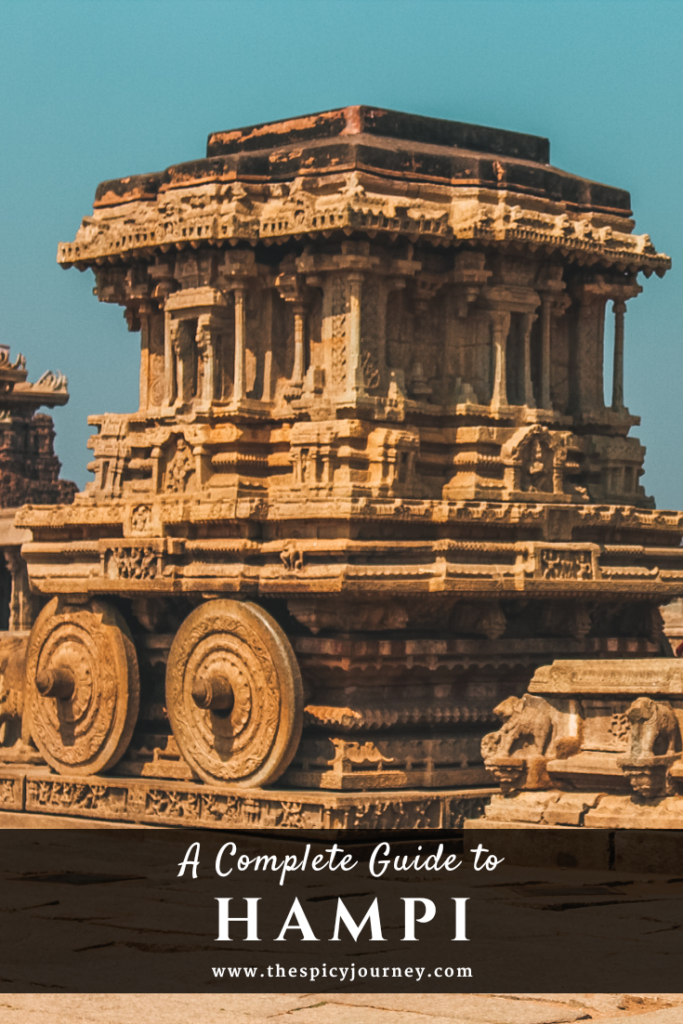
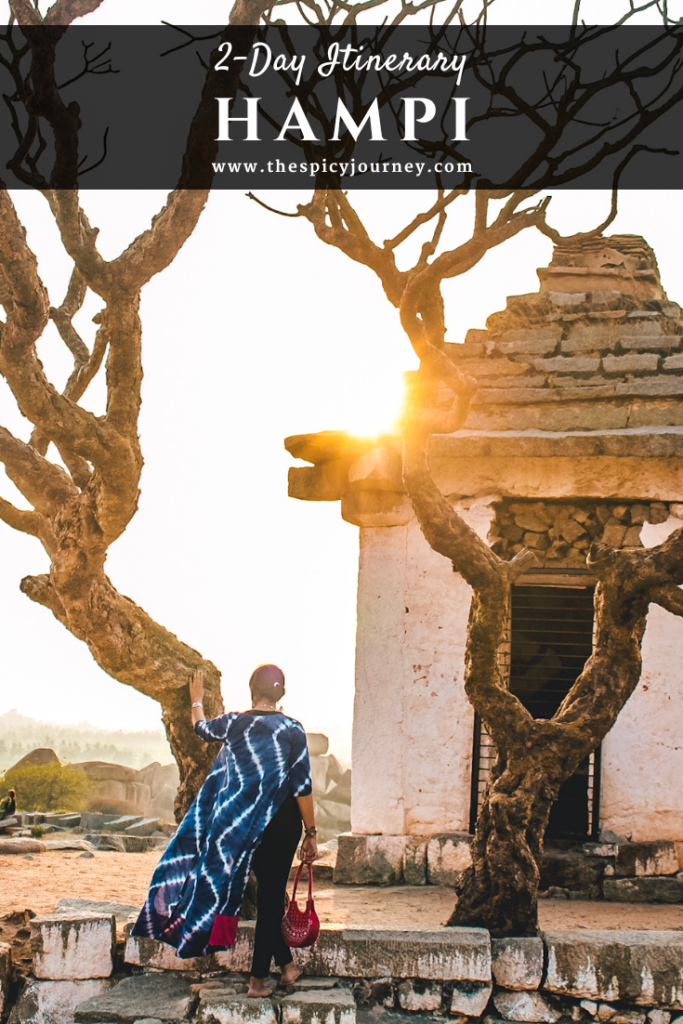
How Many Days to Spend in Hampi?
In all honesty, Hampi is a place to visit on a weekend which is why I've created a blog post for the perfect Hampi itinerary for 2 days. However, if you don't have much time or are just passing by Hampi then you can even cover all the places to visit in Hampi in 1 day itself. On the other hand, if you're backpacking and wish to chill out for a while, then you can end up staying here for much longer, probably around 5-10 days even. So the choice is all yours - you can cover everything in two days or according to your schedule - there are no rules here.
HAMPI ITINERARY - DAY 1
1. Virupaksha Temple
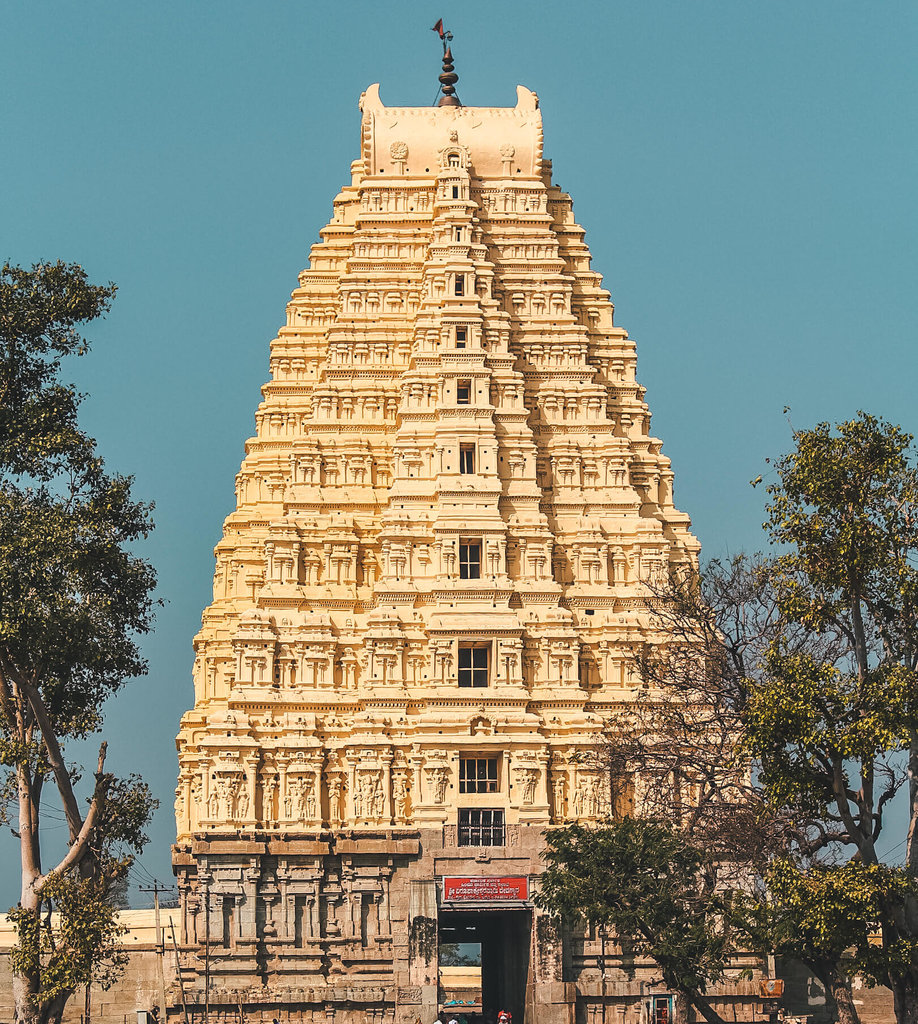
Dedicated to Lord Shiva, the Virupaksha or Pampapathi temple is the main center of pilgrimage in Hampi. Having been around since the 7th century, the temple started out as a little shrine which was later developed into a vast complex under the Vijayanagara rule. The temple consists of a shrine, a hall with innumerable pillars, three antechambers, courtyards, gateways and a few smaller shrines. The temple has three towers. The nine-tiered eastern tower rises 50 meters and dates back to the first half of the 15th century. Moreover, this tower has been built such that an inverted shadow of the tower falls on the western wall of the temple through a small hole. Ancient India was well-aware of the concept of the pinhole camera! While the northern gopuram has five storeys, the inner eastern gopuram is three storeys high. The temple attracts huge crowds in the month of December for the marriage festivities of Virupaksha and Pampa.
2. Hampi Bazaar
Once a thriving marketplace during the Vijayanagara rule, Hampi Bazaar was a well-planned market area. Located in from of the Virupaksha temple, the bazaar stretches for over 1 kilometer. While in the ancient times, merchants from foreign lands used to sell precious stones, jewelry, silk clothes, today the market still lives on, although it isn't as alluring. The current market has shopkeepers selling handmade jewelry, wall art, embroidered shawls, bags, stone figurines and the likes. Unfortunately, the market was closed down recently so anybody visiting Hampi henceforth can only look at the pavilions and imagine what the market used to look like.
3. Archaeological Museum
The Archaeological Museum, located 350m from Sri Virupaksha Temple, houses sculptures and antiques from different periods. The museum is in 4 sections.
The first section contains two scaled models of the Hampi topography along with monuments and temples located on it. This gives visitors an idea of the relative locations of the sites. the models also display the hills and rivers in Hampi.
The second section contains a large collection of sculptures and idols collected from the Hampi ruins. Most of these artifacts belong to Shiva worship and Veerabhadra cult.
The third section of the museum contains a collection of arms, coinage, tools, metal objects and other artifacts that were popular during the reign of the Vijayanagara Empire. A noteworthy exhibit in this section are documents made of brass and bundled together as a book using a ring.
In the fourth section you will find several antiquities that date back to the pre-historic and proto-historic eras. These objects are the oldest of all exhibits in the museum.
4. Vijaya Vittala Temple
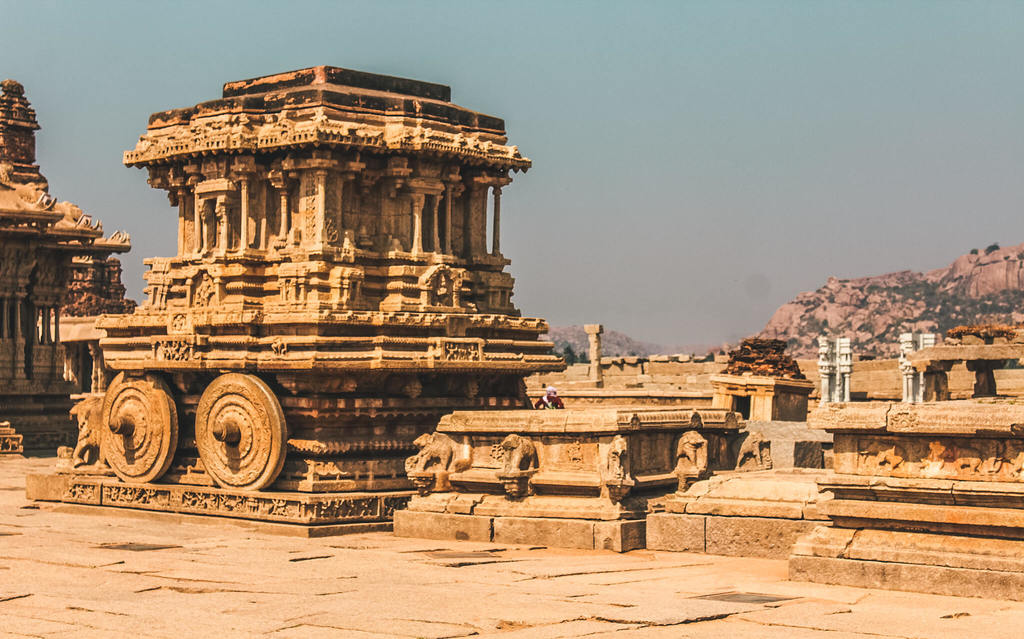
No Hampi itinerary is complete without a visit to this structure! The most popular and the grandest of all structures in Hampi, the Vittala Temple is dedicated to Vittala, an aspect of Lord Vishnu. The sprawling campus features iconic structures such as the main temple, a stone chariot, pillared pavilions, halls and gateway towers. The temple, built in the Dravidian style of architecture, exemplifies the immense creativity and architectural magnificence possessed by the sculptors and artisans of the Vijayanagara empire.
The front of the temple houses a memorable intricately sculpted stone chariot. The chariot is a shrine dedicated to the eagle God, Garuda. Another interesting structure is the maha mandapam, which has the most fascinating and famous part of the temple—the musical pillars. Carved out of a single rock, each of the massive pillars emits a different musical tone. The British, curious to discover the secrets of the musical pillars, cut two of them open. However, they were unable to find any device inside the pillars. The two pillars along with the others are still present for visitors to admire.
An extravagant architectural masterpiece, the Vijaya Vittala temple is the most visited and the most photographed site in Hampi. This place just cannot be missed. It's one of the most spectacular sight in Central and Southern India.
5. Saasivekalu Ganesha Temple
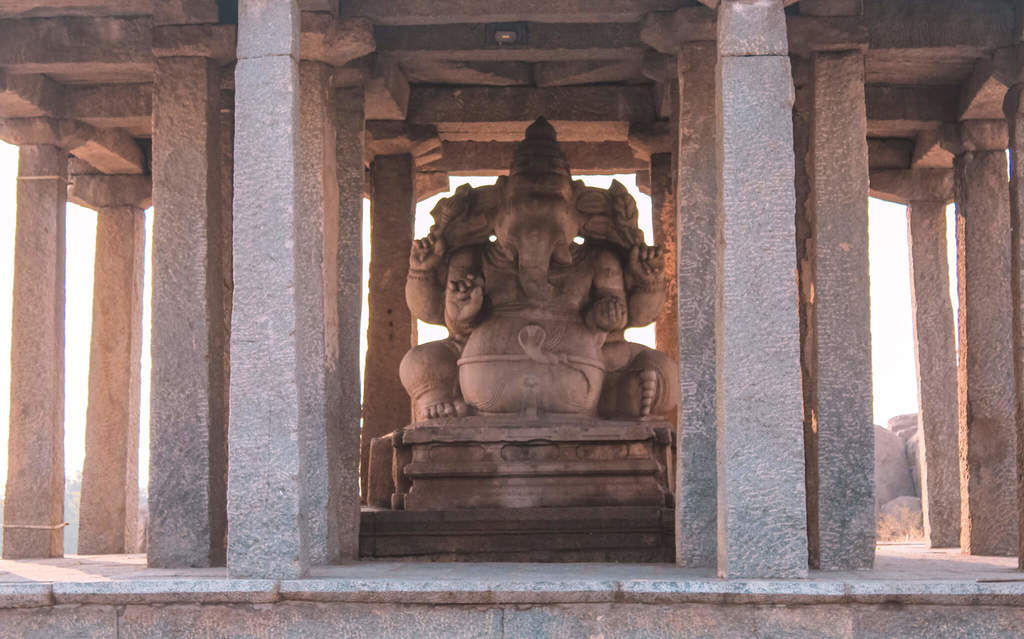
A huge statue of Lord Ganesha, carved out of a single rock is the main attraction of the Saasivekalu Ganesha Temple. The enormous statue rises to a height of 8 feet. This idol is seated in a large open mandapa (hall) surrounded by an open pavilion. If you observe carefully, you will find inscriptions on the pillars made by traders from Andhra Pradesh. These inscriptions are as old as 1200 AD and say that this status was build in memory of King Narasimha the Second of the Vijayanagara Empire. This temple is situated just 700 m away from Virupaksha Temple.
Must Read: Trekking the 5 Gokarna Beaches
6. Hemakuta Hill Temple Complex
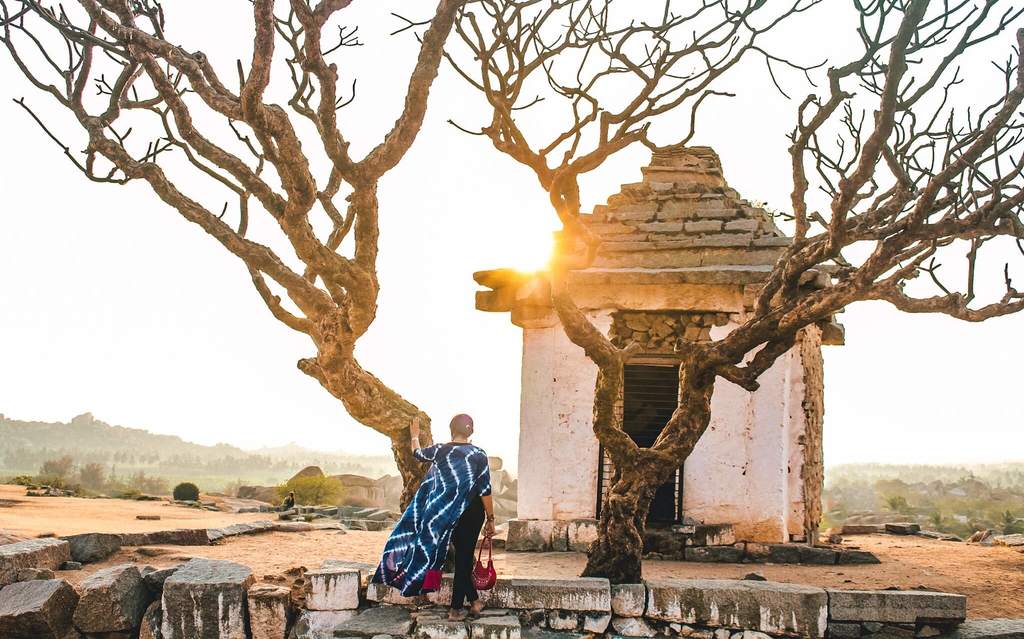
The Hamekuta Hill Temple Complex is without a doubt, my favorite spot in Hampi. The cluster of ancient temples, archways and pavilions is situated just 200 m from the Saasivekalu Ganesha Temple. Some of these temples dates back to 9th to 14th century and thus belonging to the era before the Vijayanagara Empire was founded. This hill is one of the best places to watch the sun go down. Besides, this hill is much easier to climb than the nearby Matanga hill.
Legend has it that Lord Shiva did penance before marrying a local girl, Pampa. Shiva was impressed by her dedication for him and thus consented to marry her. On this day it rained gold on this hill. Hema in Sanskrit language means gold. The name of the hill thus connects with this legend. Hence a number of temples in this area are dedicated to Lord Shiva, the major one being the Virupaksha Temple at the north of this hill.
Get here at least an hour and half before sunset. The place will be empty for you to click photographs. As sunset gets closer, the place will be swarming with tourists.
HAMPI ITINERARY - DAY 2
1. Queens’ Bath
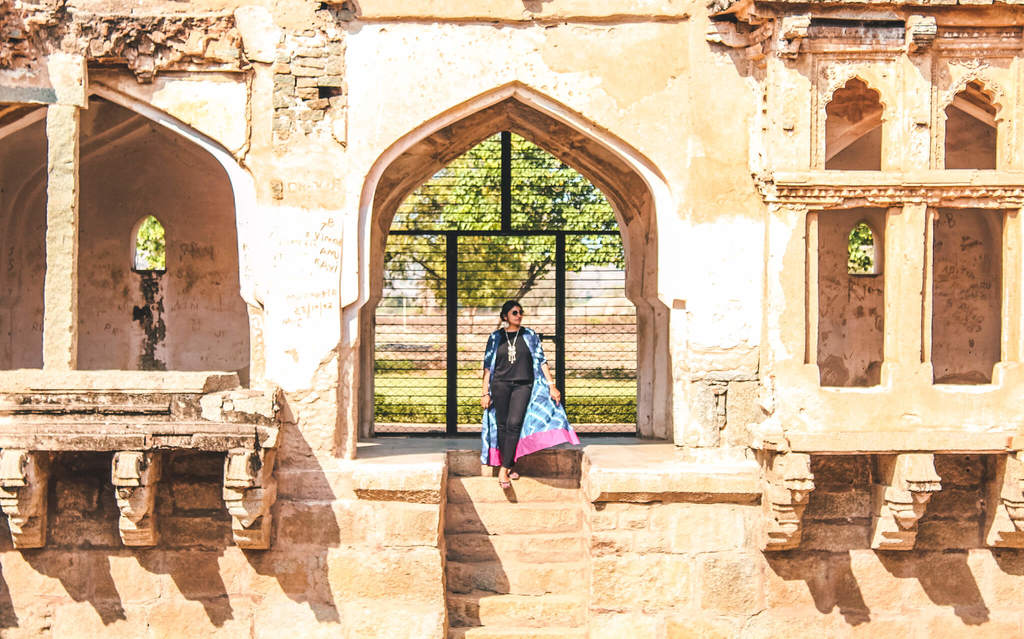
Start your second day at Hampi with a visit to Queens' Bath. The ornate structure, spread across 30 sq. m has a large sunken open-sky bath in the center. The rectangular bath is surrounded by a big verandah, extended balconies and carved domes. The balconies are decorated with tiny windows and supported by lotus bud tipped brackets. The ancient unassuming building is an epitome of the luxurious life of the royal families.
The bath, although it's named as Queens' bath, was used by both Kings and Queens. In fact, it served as a royal pleasure house. From here, you can move on to the Royal Enclosure and the Zenana Enclosure.
Must Read: Places to Visit in Goa in 3 Days
2. Dasara Dibba
Also known as the Mahanavami Dibba, the Dasara Dibba is an itricately carved stone platform located 650 m from the Queen's Bath. It was build by the King Krishnadevaraya after his conquest over the kingdom of Udayagiri, present day Orissa. The platform is about 12 m in height and played a prominent role during the Navaratri celebrations. The King used to sit atop this platform and watch the celebrations in the form of march pasts, sword fighting wrestling and royal processions. This is the first stop inside the Royal Enclosure.
3. Stepped Tank
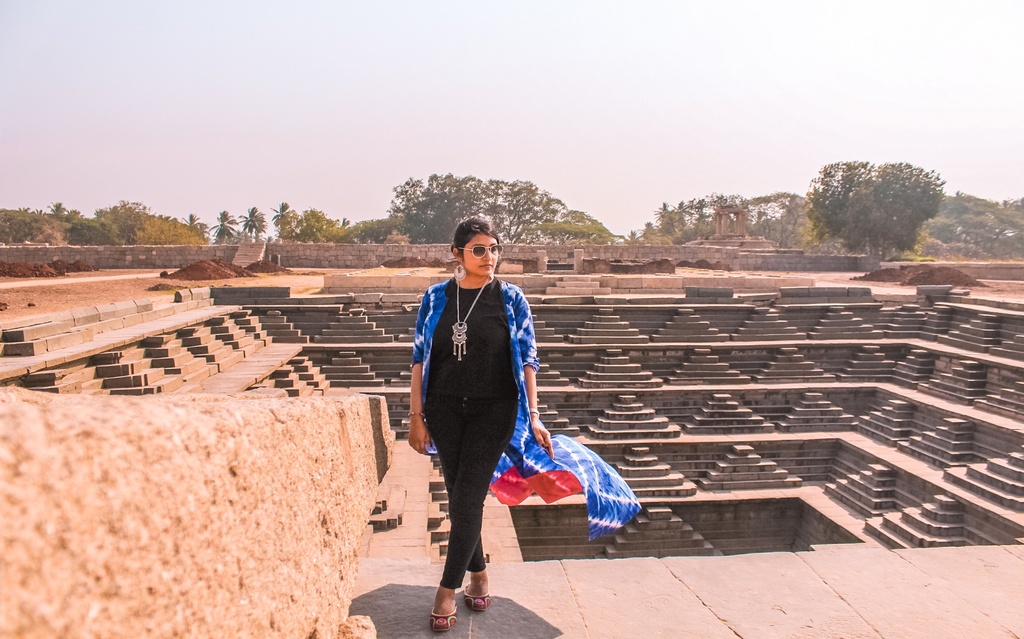
Stepped Tank of Hampi or Pushkarni is located just 190 m from Dasara Dibba. A pushkarni is a sacred water tank that is usually attached to a temple. This tank is located inside the Royal Enclosure and is said to be used by the royals during religious ceremonies such as rituals, cleansing and during rites of concretion. The ornate tank is constructed out of finely finished blocks of black stones and displays architectural beauty. The mason marks on the individual blocks of stones mark the direction of flow of water. This tank is a sight to behold and cannot be missed when in Hampi !
4. Hazara Rama Temple
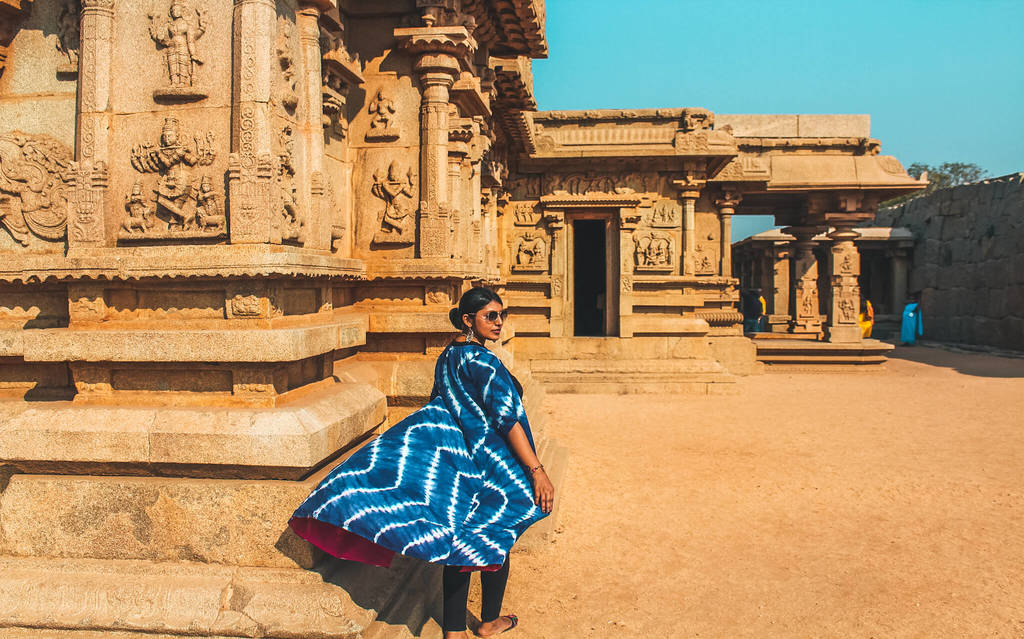
Beyond the stepped tanks, 700 m away lies the resplendent Hazara Rama Temple. The small yet elaborately carved temple is dedicated to Lord Rama. It was once the private temple of the kings and the royal family of Vijayanagara. The relationship between the temple and the royal family is depicted in the reliefs covering the outer surface of the compound walls. They portray pictures of elephants, horses with attendants, military contingents and dancing ladies.
The most stirring feature of the temple is that the walls of the temple carry the entire story of Ramayana carved on stone.
5. Lotus Mahal

The Lotus Mahal, at a distance of 500 m from the Hazara Rama Temple is located inside the Zenana Enclosure. This enclosure was the residential area of the queens. Only lady guards and maids were allowed inside this area. The Lotus Mahal is named such due to the top view of the structure, which resembles a lotus flower. The picturesque palace is a two-storeyed building which is a fine example of Indo-Islamic architecture. The palace is surrounded by trees and a grassy area, making it a scenic site.
Must Read: A Complete Guide to Kodaikanal
6. Elephant Stables
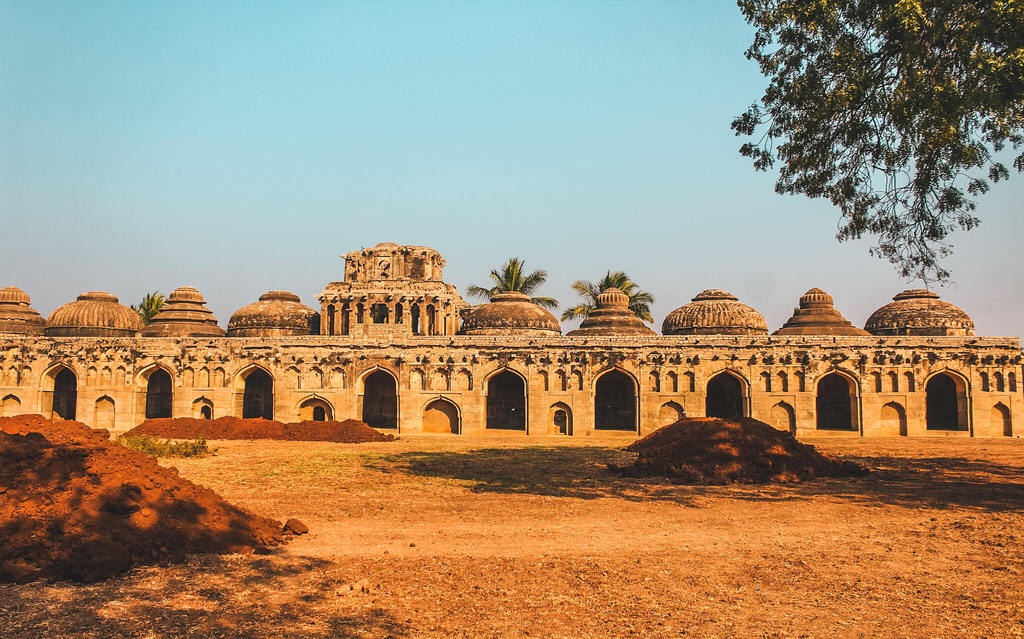
A stone's throw away from Lotus Mahal lies the Elephant Stable. This impressive long building with a row of domed chambers was used to ‘park’ the royal elephants of the grand Vijayanagara Empire. The whole building looks symmetric with respect to a central hall. The tower of the central hall resembles that of a temple shrine. However, the domes to either side of the central dome are alternately of Islamic and Buddhist style. All the chambers have high ceilings and have a small opening at the rear from where the mahouts could enter and exit. There is a central hook embedded in the ceiling of the central dome which was most likely used to hook the elephants. Also noteworthy is a hidden staircase which is used to reach to roof of the building. The guards' barracks are located next to the elephant stables.
7. Malyavantha Raghunatha Temple
https://www.instagram.com/p/BesVSVchDXV/
Approximately 4 km from Zenana Enclosure and 4.5 km from Vijaya Vittala temple lies the Malyavantha Raghunatha Temple. According to mythology, Rama and Lakshmana were looking for a shelter during the monsoon season. Rama aimed an arrow in the Malyavanta hill direction. Hence, Rama and Lakshmana stayed here till the monsoon rains are over, before they marched to Lanka along with the army of vanaras. The temple complex is typical of any temple in Hampi. Further along the temple, an archway leads towards a cliff of boulders from where you get a panoramic view of Hampi's open fields. This spot is perfect for taking pictures and idly enjoying the sunset.

1 Day Hampi Itinerary
If you have just 1 day in Hampi, visit only the following Hampi attractions:
- Virupaksha Temple
- Vijaya Vittala Temple
- Queens' Bath
- Royal Enclosure
- Dasara Dibba
- Stepped Tank
- Hazara Rama Temple
- Zenana Enclosure
- Lotus Mahal
- Elephant Stables
- Saasivekalu Ganesha Temple
- Hemakuta Hill Temple Complex
If you have some time to spare, visit the Malyavantha Raghunatha Temple. All of these are doable in one day if you start your day early.
Restaurants in Hampi - Where to Eat
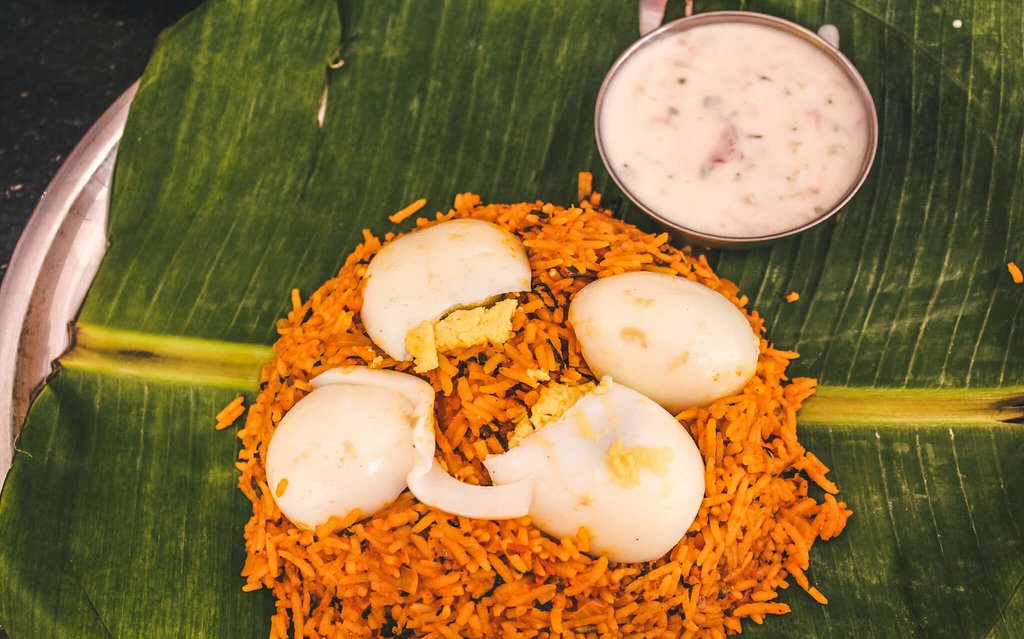
Hampi has some of the finest restaurants and cafes serving scrumptious food. My favourite one is Mango Tree, shown in the picture above. The restaurant is quite popular among the foreign crowd and there's never a time when the place is empty. They serve individual meals, which I think is great. Other popular restaurants in Hampi are Gowthami Guest House, German Bakery, Laughing Buddha and Ganesh Chillout. You'll find a good mixture of Israeli, South Indian and continental cuisine in most places.
Where to Stay in Hampi - Hotels in Hampi
Being a popular destination, there's no shortage of hotels in Hampi. Most people choose to stay in Hospete, a tiny city on the outskirts of Hampi.
Did You Enjoy Reading this Hampi Itinerary?
If you liked reading this Hampi itinerary for 2 days and the additional Hampi 1 day itinerary that I’ve put together based just for you then follow me on my social media handles Instagram, Facebook, Pinterest, Twitter to receive quick updates and be the first one to know when I release a new blog post!
Been there some years back, but surely a place I would look to visit again. Did you do the throw the coin in the water-body thingy? you ought to have visited the sloth bear sanctuary too. They look cute as teddy bears. Just a bit outside Hampi.
This place is amazing, I want to go back to India right now! Indian temples are so beautiful and I love the stories and legends behind them, like that of the Malyavantha Raghunatha temple.
I’m a massive fan of the Indian mythology too! Do come back to India soon to explore some temples 🙂
I’ve never heard of Hampi but I love your photos of it. Two days seems like the perfect amount of time to spend there. I have always like statues of Ganesha, so I think that would be the sight I’d most want to see.
Thank you Stella. Yes, 2 days was just about right for Hampi 🙂
What an amazing blog! I was in Hampi just a few months ago.. i could literally relive my memories through your blog! Loved it.. ?
Thanks Kanika. Happy to refresh your memory !!
Oh man, my list of places to see in India only gets longer. Hampi looks incredible with all the temples to explore. And that stepped tank is something to marvel at.
Haha India has a never-ending list of monuments, temples, forts and what not. The stepped tank is indeed a marvel and a unique identifier of India.
Loving your dress. These are beautiful architectures. Makes me want to visit India more.
Thank you !! Do try to visit India as soon as you can 🙂
I was in Hampi last November and it was my second time! I can definitely not get enough of that place. One thing is true indeed -you need atleast a week to see it well!
Oh yes!! I wouldn’t mind spending a week there!
Your article reminded me about my journey to hampi few years ago. And I spent there exactly two days. I wish I know your blog back then that would be very helpful information.
I’m glad you liked my blog 🙂 I hope I can inspire more people to refer to my guides and take trips !!
Oh, Hampi! It is such a wonderful place. I had been there last October and it was an amazing trip. I went on a nostalgic trip reading your post. But yes, you need a lot more time to explore and understand Hampi. Loved the post!
Thank you Amrita!! I’m glad you were able to refresh your memory through my blog 🙂
Hampi is on my India’s must-visit places to explore given credit to its history. I have known a little bit about the Vijaya Vittala Temple, but the rocks of the pillars emits music, that must be something to experience. I would love to see the Queen’s bath, its grandeur is imminent.
The musical pillars were out of a fairy tale! It’s forbidden to play music on the pillars now but some guides do it anyways. I’m guilty of listening to it but it was a great experience!!
This looks like such a cool place! I want to visit Hampi and this looks like a really detailed guide. Thanks for sharing!
Pingback: How to Spend 2 Days in Gokarna - The Spicy Journey
Pingback: Things to do in Pondicherry - The Spicy Journey
Hellow my name is Martinpeado. Wery good post! Thx 🙂
Pingback: Gokarna Beach Trek - Hiking to the Gokarna Beaches - The Spicy Journey
Pingback: The Most Instagrammable Spots in Goa - The Spicy Journey
Hey!
I’ve always wanted to visit Hampi. I have visited North India but not the South yet! I’m looking to go back next year and have found this itinerary really helpful! Thankyou so much! Hampi looks a beautiful place. Was it peaceful? Out of curious did you not get temple fatigue seeing that many in one day?
Love
Alex
xxx
Hey Alex! South India is beautiful and I’m glad you’ll be making your way here soon. I, personally, did not get temple fatigue in Hampi because each of them is quite unique. If you notice all the points of interests mentioned in my post, each location has it’s own backstory, which was quite intriguing. That being said, Hampi is turning into a hippie paradise and you can easily stay here a few days to relax.
Pingback: 1 Day Bangalore Itinerary - How to Spend 24 hours in Bangalore - The Spicy Journey
Can you suggest good hotels around Hampi with good food and hygiene taken care off
For mythology lovers, there’s more in Hampi. There is Anjaneya Parvat, believed to be birth place of Lord Hanuman, the monkey god of epic, Ramayan fame, atop a hill with 575 steps. It also gives a 360° panaromic view of the area.
Also there is Kishkindha, the abode of Bali & Sugreev as also the cave in which Bali fought a demon.
One can also visit Pampa Sarovar, one of the 5 sacred sarovar of hindus, besides which is the place where Sabri fed Ram & Laxman with plumbs and guided them to seek help of Bali to search Sita, called Savari Ashram.
Hi,
Your blog served as a reference for me to visit hampi over the weekend on a solo trip. Created a list of places from your blog and visited all of them. Thanks for writing 🙂